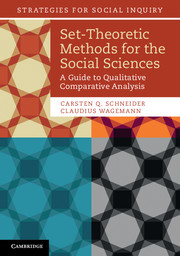Book contents
- Frontmatter
- Contents
- Figures
- Tables
- Acknowledgements
- Introduction
- Part I Set-theoretic methods: the basics
- 1 Sets, set membership, and calibration
- 2 Notions and operations in set theory
- 3 Set relations
- 4 Truth tables
- Part II Neat formal logic meets noisy social science data
- Part III Potential pitfalls and suggestions for solutions
- Part IV Variants of QCA as a technique meet QCA as an approach
- Glossary
- Bibliography
- Index
4 - Truth tables
Published online by Cambridge University Press: 05 November 2012
- Frontmatter
- Contents
- Figures
- Tables
- Acknowledgements
- Introduction
- Part I Set-theoretic methods: the basics
- 1 Sets, set membership, and calibration
- 2 Notions and operations in set theory
- 3 Set relations
- 4 Truth tables
- Part II Neat formal logic meets noisy social science data
- Part III Potential pitfalls and suggestions for solutions
- Part IV Variants of QCA as a technique meet QCA as an approach
- Glossary
- Bibliography
- Index
Summary
What is a truth table?
The concept of a truth table originates in formal logic. At first glance it might look a lot like a standard data matrix. Just like conventional data matrices, each truth table column denotes a different variable or, better, set. The difference consists in the meaning of rows. In a standard data matrix, each row denotes a different case (or unit of observation). In a truth table, each row instead represents one of the logically possible AND combinations between the conditions. Since each single condition can occur either in its presence or its absence, the total number of truth table rows is calculated by the expression 2k. The letter k represents the number of conditions used and the number 2 the two different states (presence or absence) in which these conditions can occur. Each row denotes a qualitatively different combination of conditions, i.e., the difference between cases in different rows is a difference in kind rather than a difference in degree.
The formula 2k yields the number of logically possible combinations or truth table rows or, slightly misleadingly, logically possible cases. The number of truth table rows increases exponentially with the number of conditions. With three conditions, we end up with eight configurations. With 4 conditions, we already have 16 configurations, with 5 we have 32, and with 10 we have no fewer than 1,024 logically possible cases. In social reality and therefore also in social science research practice, not all of these potential cases materialize empirically. The whole of Chapter 6 is dedicated to the phenomenon of limited diversity and provides strategies on how to handle logical remainders (Ragin 1987: 104ff.). For the time being, and in order to properly introduce the meaning and analysis of truth tables, in the current chapter we only deal with truth table rows that do not show any such logical remainders.
- Type
- Chapter
- Information
- Set-Theoretic Methods for the Social SciencesA Guide to Qualitative Comparative Analysis, pp. 91 - 116Publisher: Cambridge University PressPrint publication year: 2012

